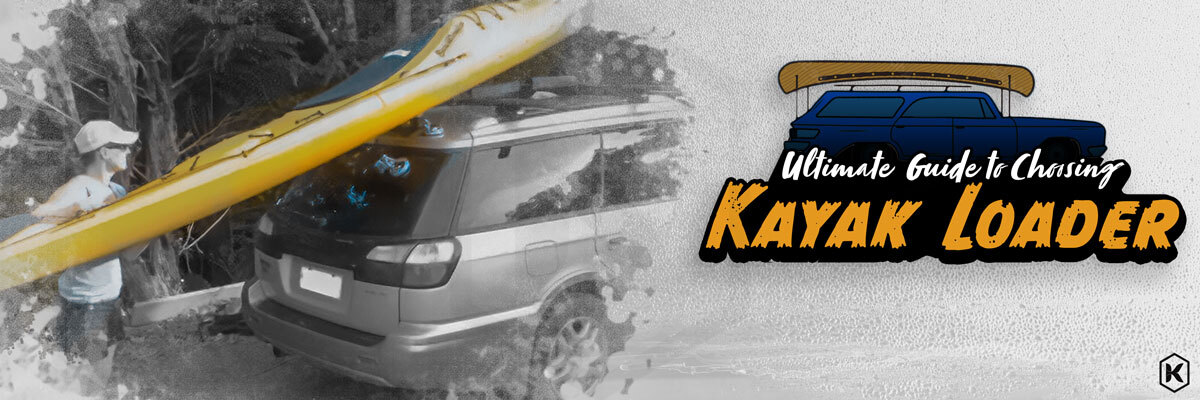Ultimate Guide to Choosing Kayak Loader

A set of roof racks is the best way to transport a kayak, but it can be challenging if you're loading one by yourself. Usually, you'd need two people to load a kayak, with one person to lift at the front end (bow) and someone else at the other end (stern). For especially tall vehicles (4WD, vans, etc.), you may even need to use ladders, which can be very unstable, particularly with long loads.
The best method for getting your watercraft loaded onto a set of roof racks is with a universal side loader or roller-rack loader. Loaders are commonly referred to as lift-assist carriers, and they can help get your kayaks loaded after a hard day on the water. This article is aimed at helping kayakers decide if a loader is suited to their particular situation and to answer some of your burning questions!
Using roof racks with a kayak loader
Roof racks are the most common form of transport for kayaks on land. But, lifting a kayak onto your car can be challenging for some people, and this is where kayak loaders are considered a most useful accessory to add to your gear.
All kayak loaders are suited to one-person operation, and they'll assist with loading and unloading different sized kayaks. In addition to kayaks, loaders can help with other long gear that you may transport on your roof racks (boats, timber, etc.). Kayak loaders are suited for many purposes and can help with quickly loading anything you need to store on your roof racks.
Kayak loaders designed for Rhino-Rack universal roof racks
If you have a Rhino-Rack branded roof rack, then you'll find an adjustable watersport carrier to suit. Roller racks are best suited to most rook racks, and they temporarily attach to your vehicle back window. Fitting a roof rack universal side loader to your vehicle will make for a complete system. It'll remove many of the obstacles you get with loading a kayak.
Kayak loaders for any vehicle's roof racks
A kayak loader (or canoe and boat loader) can help protect your vehicle as it offers a smooth operation for getting your gear loaded. A loader is mainly designed for use by one person, but if you're loading more than one kayak, it can be helpful to use two people to get the kayaks into position and tie them down properly. A loader can take what may have been impossible for one person into an easy task that gets your gear loaded up fast and safely.
FAQ for kayak loaders
Loading a kayak
Can you load a kayak by yourself?
Using a kayak loader allows you to load a kayak when you're alone quickly. If you are physically fit and capable of lifting your kayak (weights of about 20kg), then it may be possible to get the kayak onto your roof racks alone.
How do you load a heavy kayak?
Heavy kayaks (anything over 20kg) are best suited for loading by two people. When loading and unloading, one person can lift the rear and the other the front. Remember to lift at the knees and then lift the kayak onto your vehicle's roof.
How do I get a kayak on top of my car by myself?
Loading kayaks and canoes are best completed with the assistance of a universal side loader or rear loader. While most kayaks are considered lightweight, the easiest method to get them onto your car (especially after a long day on the water) is with a lift assist carrier.
How do you use a kayak loader roller?
Kayak rollers are designed for easily loading kayaks from the rear of your vehicle. You can lift the front of your kayak onto the rollers and then lift it from the rear. The rollers are designed to support your kayak while you push it onto your roof.
Using roof racks
How do I put a kayak on top of my car?
A rack universal side loader is one of the easiest methods to load a kayak in a one-person operation. These loaders are a complete system that allows for the easy loading of any kayak (fishing kayak, etc.).
How do you load a kayak on a ute?
Kayaks under 3m will fit into the tray of most utes. You can put the kayak in and have a part of the stern hanging out of the tray. You may need a set of roof racks for longer kayaks and load the kayak onto those.
Should a kayak be transported upside down?
The way you transport a kayak depends on what style you own. Most sit-on-top kayaks are suited to transporting upside down, and you can use a side loader to get these onto your roof racks. Most V-shaped kayaks are better transported in cradles, loaded using roller racks.
Can I build a DIY kayak loader?
It may be possible to build your own kayak loading gear if you're handy. When you craft your loader, you'll need to carefully plan how you'll load and unload your kayak (or canoe).
Where to buy the best kayak loaders
At Kayaks2Fish, we have an excellent range of kayak loaders to suit your roof racks. For rear lifting onto any roof rack, there is the K-Rack loader. For single person loads onto hard rails, you can use the Rack & Roll loader for kayaks up to 34kg (kayaks up to 65kg will need optional load support poles).
The Yakima Showboat is designed for rear loading and will fit on any hard rail roof racks. These loaders will pull out from the roof racks and provide a stable point to load any kayak. For an even easier time loading, you can use them in conjunction with the Yakima Sweetroll. However, these two systems can be installed independently from each other and provide excellent support when loading your kayak alone.
If you need any assistance in choosing the best kayak loader for your vehicle, please call our team, and we'll be happy to provide our expert advice. If you want to easily load a kayak and save yourself the hassle and possible strain, then getting a premium kayak loader is the way to go!










